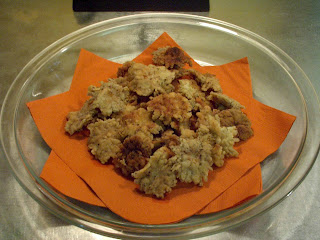One of my fondest childhood memories is running through Farmer Sowder’s over-grown pasture, collecting Milkweed pods, and blowing the silk-tufted seeds into the air. As they caught on the breeze and floated up into the sky, I would make a wish, imaging the tufts carrying my wishes to heaven. I could stand in that pasture for hours, simply watching the tufts disappear into the vast blue sky.
However, Milkweeds are more than just a plaything or nuisance weed. They are an palatable treat sought after by wild edible coinsures and bizarre foods adventurers. No, this is not an “I dare you to eat this” food. When prepared properly, Milkweeds actually have an interesting flavor, tasting somewhat like tart asparagus.
Foraging: The Milkweed has a unique, stately appearance, making it one of the easiest wild edibles for the novice forager to hunt. It is a sun-loving annual that grows prolifically along roadsides, railroads, fallow fields, and fence rows—just about anywhere it’s floating silk-tufted seeds may fall.
Milkweeds have a stout, unbranched central stalk, 2-5’ tall, that is covered in downy fuzz. Attached along the top half of the stalk, in a symmetrical pattern, are large thick leaves, 2-4” wide, 4-9” long, oblong or oval in shape, with wide central ribs, the underside covered in downy fuzz. Large, spice-scented, lavender-purple flowers appear in midsummer. The large flowers have five curled petals, five hairy sepals, and five nectar horns. In late summer, the flowers give way to large horned-shaped pods covered in wart-like bumps. At maturity, the pods burst, releasing silk-tufted seeds. All parts of the plant exude a sticky, thick, milky sap when broken, hence the name Milkweed.
Caution: All wild edibles have at least one toxic doppelganger. The Milkweed’s poisonous twin is Dogbane. However, while Dogbane excludes the same milky sap when broken and occupies the same habit, Dogbane is not covered in downy but smooth, distinctly branched, and has tiny, pink-striped, bell-shaped flowers.
Always verify the identity of a possible wild edible before harvesting it! Reference a wild plants picture book, the internet, or ask your high school’s biology department. It’s better to be safe than sorry. Trust me, you won’t like the alternative.
Milkweed Sauté
Plunge cleaned stems into salted boiling water and boil for 1 minute. Drain and immediately blanche stems in cold water to halt cooking.
Plunge a second time into fresh salted boiling water and boil for 1 minute. Drain and immediately blanche stems in very cold water to halt cooking.
Plunge a third time into fresh salted boiling water and boil for 1 minute. Drain and immediately blanche stems in very cold water to halt cooking.
The Milkweed stems should now be bitter free, and ready for cooking!
In a heated sauté pan, add equal parts of butter and olive oil.
Season oil with fresh or dried garlic.
Heat oil on medium high.
When oil starts softly turning, add Milkweed stems.
Season Milkweed with salt and pepper.
Sauté until tender.
This dish is also tasty served with a cheese or cream sauce.
Hint: When serving anything with “weed” in the name, it’s best not to tell your family and friends what they’re eating until after they’ve tasted it.







